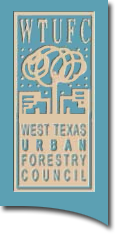Energy Conservation
 Here in the Southwest, peak demand of electricity is highest late in the afternoon on hot summer days. Most power plants burn fossil fuels, which add Carbon dioxide (a greenhouse gas) to our atmosphere. Power plants use more water, which evaporates, in their cooling towers to meet our increased energy demands. Knowing that trees planted today will help reduce our future energy needs, electric companies across the nation actively support tree planting projects and programs.
Here in the Southwest, peak demand of electricity is highest late in the afternoon on hot summer days. Most power plants burn fossil fuels, which add Carbon dioxide (a greenhouse gas) to our atmosphere. Power plants use more water, which evaporates, in their cooling towers to meet our increased energy demands. Knowing that trees planted today will help reduce our future energy needs, electric companies across the nation actively support tree planting projects and programs.
Energy conservation is one benefit of trees many people fail to recognize. It is well documented that “Urban Heat Islands”, which we call cities, are up to 12 degrees F warmer than their rural surroundings. Current research indicates that by strategically planting one large tree on the west side of a typical residential home, cooling costs can be reduced by about 9%, saving 250 kilowatt-hours. Imagine what two trees might do.
Some communities are involved in a "Cool Communities" program. In combination with tree planting, lightening of dark colored surfaces also helps to save money and energy. Here are some guidelines to follow for energy savings when designing your next landscaping project:
Southern Exposure
Avoid planting trees on the south side of the house. In the winter the sun is lower on the horizon and we can gather warming rays through our southern facing windows and walls. Plant ground covers, or low growing shrubs instead.

East & West Are Best
Deciduous trees planted on the east and west sides of your home will shade your walls and roof in the summer while letting in the sun’s warming rays in the winter.

Cooling Your Cooling Unit
Planting a small tree near your air conditioning unit will help it to operate more efficiently, while still allowing for air circulation.

Windbreaks
Planting a row of evergreens on the northwest side of your lot will help deflect the cold winter winds and provide protection from the spring winds. If planting space is not available on a small residential lot, a community shelterbelt may be more practical.

© 2010 - 2017 West Texas Urban Forestry Council
